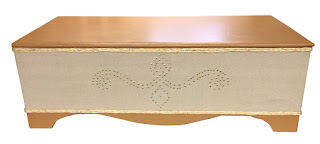 |
| Pine Chest |
This old pine chest was once covered with a natural fibrous material, then after it was removed, someone had painted it with gloss black paint directly over the residue of glue and fibers left over from the previous surface. (Look below to see how the background looked as well as the fiber that had covered the chest).
The customer thought it was a cedar chest, but it turned out to be made from pine boards, not cedar, which has a distinct look and fragrance.
 |
| Top of Chest |
Since the side surfaces were so rough, the only
way to make it look good again was to cover it with fabric. We were able to sand the top enough for it to accept paint and look pretty good, so we decided to paint the top and bottom with “gingerbread brick” paint and spray glue tan canvas duck fabric to the sides. It covered the rough exterior very well and gave it a fresh, new look and a chance at a new life.
With polished hardware, it turned out to be a nice piece of furniture. This was a decent sized storage chest, but light enough to be easily relocated if desired. I decided on adding two rows of rope to the top and bottom edges for more texture and to create a “pirate” chest look. For a final embellishment, I created a swash design, then transferred it to the front with a Frixion pen (which is easily removable once the project is complete) and then followed my hand drawn pattern with shiny brass tacks. These tacks not only created a lovely design, they help to keep the fabric in place, which I had adhered with Gorilla spray glue. All in all, a very fun fall project.
 |
| Sample of exterior |
 |
| New Canvas on Background w/new handle |




